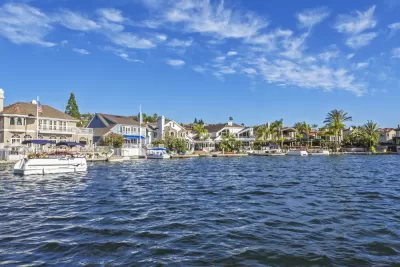The Southern California county has long been a pioneer in water management.

The Orange County Water District will begin expanding its water recycling program in 2017, and by 2023, aims to produce 130 million gallons of recycled water every day—enough to serve about a million people, make the area less reliant on imported water, and reduce the impacts of drought.
General Manager Mike Markus, who has been with the agency for 25 years, explained the scope and genesis of the expansion project in The Planning Report.
The district is responsible for managing a large groundwater basin, including deciding how much water to withdraw. It sells that water to retail agencies, who deliver it to the residents of Orange County.
It’s a "balancing act," Markus says, to withdraw enough water for the population while keeping the basin healthy and adequately full.
To meet that challenge, the agency has emphasized preparedness and foresight. "We built expandability into the project from the beginning," Markus says.
The county has been treating wastewater since the '70s, when it became clear that the basin was vulnerable to seawater contamination. And while California's current drought has prompted real innovation at the state level, Orange County has been piloting advanced water treatment technologies since an earlier drought in the 1900s.
Markus is also overseeing the agency's planning for future demographic changes that could affect demand for water, potential challenges to financing and funding, and even the possibility of a National Infrastructure Bank under President-elect Trump.
FULL STORY: Orange County Water District Leads On Recycling & Groundwater Management

Planetizen Federal Action Tracker
A weekly monitor of how Trump’s orders and actions are impacting planners and planning in America.

Maui's Vacation Rental Debate Turns Ugly
Verbal attacks, misinformation campaigns and fistfights plague a high-stakes debate to convert thousands of vacation rentals into long-term housing.

Restaurant Patios Were a Pandemic Win — Why Were They so Hard to Keep?
Social distancing requirements and changes in travel patterns prompted cities to pilot new uses for street and sidewalk space. Then it got complicated.

In California Battle of Housing vs. Environment, Housing Just Won
A new state law significantly limits the power of CEQA, an environmental review law that served as a powerful tool for blocking new development.

Boulder Eliminates Parking Minimums Citywide
Officials estimate the cost of building a single underground parking space at up to $100,000.

Orange County, Florida Adopts Largest US “Sprawl Repair” Code
The ‘Orange Code’ seeks to rectify decades of sprawl-inducing, car-oriented development.
Urban Design for Planners 1: Software Tools
This six-course series explores essential urban design concepts using open source software and equips planners with the tools they need to participate fully in the urban design process.
Planning for Universal Design
Learn the tools for implementing Universal Design in planning regulations.
Heyer Gruel & Associates PA
JM Goldson LLC
Custer County Colorado
City of Camden Redevelopment Agency
City of Astoria
Transportation Research & Education Center (TREC) at Portland State University
Jefferson Parish Government
Camden Redevelopment Agency
City of Claremont




























